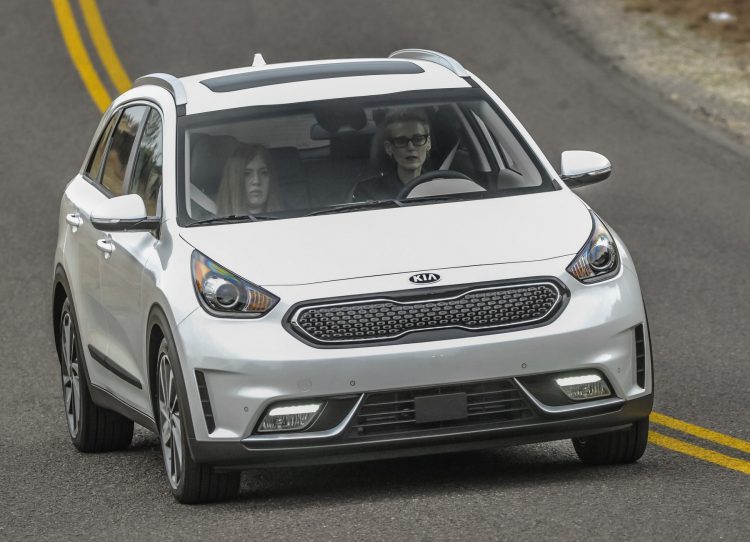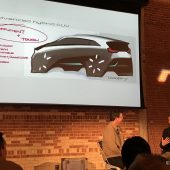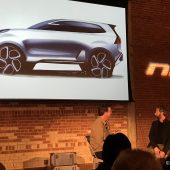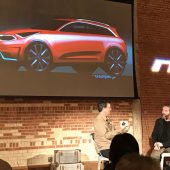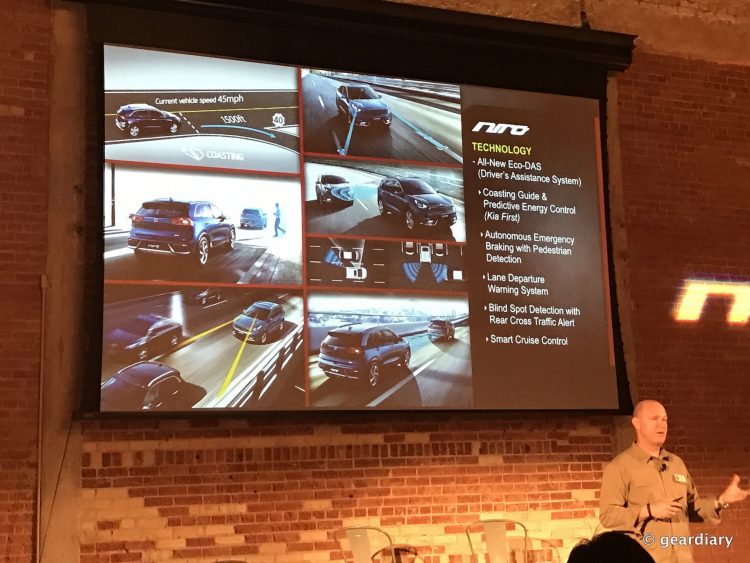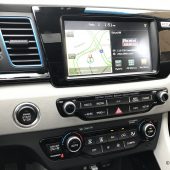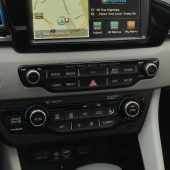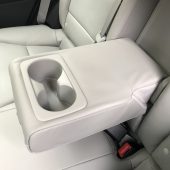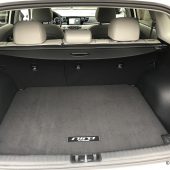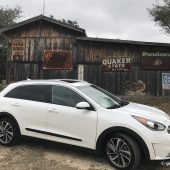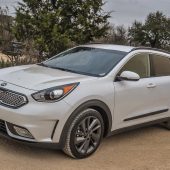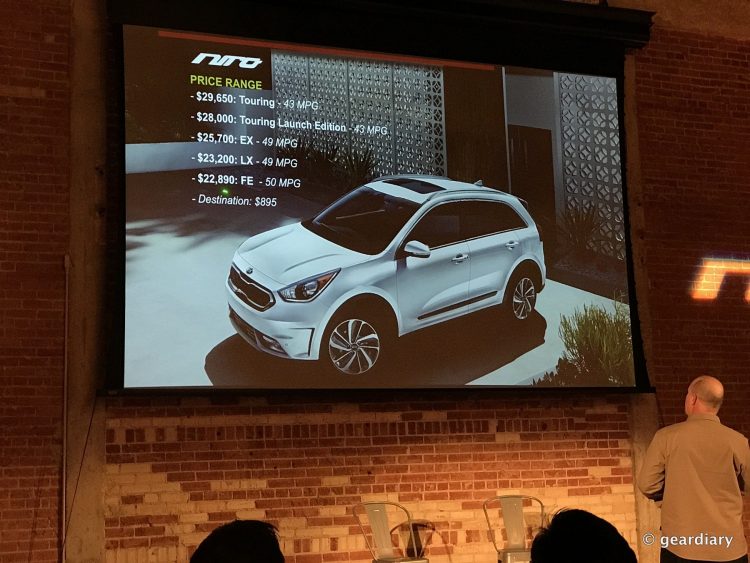Last week, along with a group of other auto writers, I attended the National Press Introduction for the 2017 Kia Niro in San Antonio, Texas. The Niro is Kia’s new crossover hybrid, poised to take on Toyota Prius customers who are ready for more passenger room and utility space.
We were based out of the new Hotel Emma, the crown jewel of the historic Pearl District. Originally Pearl Brewery’s brewhouse, the hotel is eclectic with a steam punk vibe. If you haven’t been to San Antonio in a while, it is worth staying here and checking out the area, but I digress.
Kia has been in the United States for about 23 years, and they have sold 6.6 million vehicles; by June, they estimate that they will have sold their 7-millionth Kia. I’ve mentioned it before, but in 2001, Kia was ranked dead last in the JD Power Initial Quality Study Award; in 2016, they were ranked #1 in the United States by the JD Power IQS Award — the first time a non-luxury brand was awarded the top spot in over 27 years.
In 2011, Kia introduced the Optima Hybrid; in 2013, they introduced their first all-electric vehicle, the Soul EV. Along the way, in 2016 Interbrand, which ranks brands globally, ranked Kia in the top 50 for best green brands (at #35) — ahead of Starbucks. Kia has a continuing theme of focusing on the environment; they have a five-year roadmap where they are going to be reducing their fuel economy 25% by 2020. They are going to continue to invest in clean combustion, hybrids, plug-in hybrids, battery, electric, and fuel cell technologies.
Kia places a huge emphasis on dedication to quality, and their latest Niro hybrid is no exception. Would you guess that this was a hybrid just looking at it? No way, right? It looks like a gas-guzzling crossover. 😉
The 2017 Kia Niro is what Kia refers to as a “smarter kind of crossover”; it’s the first Kia to be engineered from the ground up as a hybrid, and there are no compromises in terms of its combination of style, functionality, and efficiency. In order to properly launch the Niro, Kia went back to what they did when they launched the Optima Hybrid — in 2011 they partnered with Guinness Book of World Records — when they drove the Optima Hybrid through 48 contiguous states and got about 64 miles per gallon, giving Kia a world record. That strategy worked well with the Optima Hybrid, so they did it again with the Kia Niro.
This time, they got with Guinness and they came up with a world record for the “lowest fuel consumption by a hybrid driving coast to coast across the USA.” The Kia Niro left LA City Hall and drove to New York City Hall, averaging 76.6 mpg and using just 4.1 tanks of fuel. Here’s the car that made the run …
- photo courtesy of Kia
- photo courtesy of Kia
- photo courtesy of Kia
So let’s talk about the origin of the Niro. When the team needed a designer for the Niro, they looked to Mike Torpey, the man behind the Kia Soul — from the inspiration of “a boar with a backpack”. Interviewed by James Bell, Mike Torpey told us about the experience of being given a clean slate to create a new car. Mike admitted that getting an assignment like this was nerve-wracking, but that “these are the kinds of assignments that as a designer, you hope most to be put on because you’re starting from scratch, it’s a brand new car, and there’s no baggage behind it … we can really optimize the design approach from the ground up.”
Mike wanted to take a thoughtful approach that styled the Niro as a very different car, so he started by looking at what was already out there. Hybrids have been in the marketplace for around 20 years, so “people have seen the evolution of style in these things; they’ve become, in many cases, increasingly over-styled.” One of the things they quickly realized was that people love their hybrids, that the technology behind them is awesome as gas prices go up and down, but that “people don’t buy their hybrids because of their styling, they buy them despite their styling.” They found that the way that people use their hybrids, in the same
They found that the way that people use their hybrids, in the same way that they’re trying to optimize fuel economy, there are optimizers all around. For instance, many hybrid vehicles are compact or weirdly proportioned or styled. Through all of this, they realized that there was “an increasing subconscious desire for people to be able to acquire wonderful efficiency without paying a stylistic penalty or necessarily giving up the utility that increasingly people want in crossovers, full-size utility vehicles that have more space, are more rugged, and have a higher sitting position.”
Through all this, sensing the desire for efficiency but more of an “honest embrace” of the way cars get used, the idea of a rugged modern efficiency to speak to the design team. You can see some of the early stylistic drawings made for the Kia Niro; the first picture in this series was Mike Torpey’s “telephone sketch”, his explanation being that usually “when you’re not thinking too hard about things, your subconscious is still working on it and most often when you’re chatting on the phone and doodling away, that’s when you free up your intuitive sub-brain, and that’s what comes out in the sketch.” The following pictures show the evolution of the vehicle; Mike had jotted down that he wanted the vehicle to look technical, efficient, etc … but if “you overdo these things, you end up with MAYA – or Most Advanced Yet still Acceptable to the public’s taste … You want things to be new, but you don’t want them to repel.”
The idea behind the Niro was that it be rugged modern efficiency, and the final (red) sketch showed the vehicle Mike wanted — it had a presence and a strong stance; they felt that it would be really important to people feeling confident while driving it, so “in this vehicle, there is a real defined shoulder line through the whole car, which is not very evident in a lot of hybrid vehicles — they’re kind of styled almost like slab-like appliances.” Mike said that they were “pretty insistent about getting a window graphic through the side of the vehicle that spoke to a more premium and stylistic tie-in to their vehicles like our Sorento and Sportage, a family theme of established, beautiful cars that are rugged and functional.”
As a hybrid vehicle, the challenge was to make it aerodynamic (or slippery), but then you also have a spirit that you want to show through the vehicle. So, as I mentioned, the “totem spirit” of the Soul was a boar with a backpack, so the totem for the Niro became the “Bengal tiger”. They were able to hit a 0.29 coefficient drag, which is normally seen on vehicles that are “very obviously aerodynamic, but not so nice to look at.” With the Niro, Kia hit those numbers in a way that was still highly appealing.
The most obvious competitor to the 2017 Kia Niro is the Toyota Prius, yet there are huge differences between the two vehicle’s styles. Kia wanted to do something “different, yet still be relevant.” That became their mantra going into this space.
Kia recruited people who drove Priuses (is that the right plural? I’m not sure) and other hybrid vehicles to drive the Niro with the goal of finding out what they liked about their vehicles, and three things came up: they loved the mileage, driving a hybrid was something that made them feel good, and from a practical standpoint they weren’t spending as much on gasoline, but they hated the way their vehicles looked and they didn’t like the way they drove.
In the case of young males, in California particularly, they were coming in with Priuses that had blacked out wheels and in at least one case — a ski rack on top. People from Kia asked, “how do you get this thing up to the top of the mountain?”, and the reply was, “well, I don’t ski — I just have it up there to try to make it look cool.” 😛
For Kia, that was a signal that there was an opportunity to do something new and different. The Niro concept finalized in four key development areas where Kia wanted to differentiate: practical, progressive, engaging, and efficient; that was the mantra that they used to move into this space.
The 2017 Kia Niro has plenty of built-in safety features including advanced high-strength steel structure, seven airbags, available Autonomous Emergency Braking (AEB), Blind Spot Detection (BSD), Rear Cross Traffic Alert (RCTA), Lane Change Assist (LCA) and Lane Departure Warning (LDW).
The model we drove had the top of the line trim package and a new Harman Kardon stereo system with Clari-fi. It has an 8-channel 315 watt system with a center channel to better replicate sound. The 2017 Kia Niro has the 3rd generation UVO infotainment system, which is completely subscription free — it uses your smartphone as a source and connection; there are 14 free services including geo-fencing and a parking minder. Across the board, standard on every Niro, they are all equipped with Android Auto and Apple CarPlay — even down to the FE model, which is their entry package.
The interior of the Niro has been very thoughtfully designed: the observation was made that “apart from the interior of an automobile, there is really one enclosed space that you spend a lot of time alone in.” I’m guessing the bathroom would be the other space, but that wasn’t specifically said. (I put this comment in here to see if you all are still paying attention. ;-))
But the point is that you want your automotive space to be intimate, intuitive, and calming. The goal for the Niro was that the technology would be nearly invisible and intuitive — that it wouldn’t distract — and that it would be calming. To that end, you’ll notice how the hybrid information is over to the left side of the LCD instrument cluster, which manages to look like one found in a traditional gas vehicle, yet it still has a futuristic and uncluttered feel. There’s no learning curve when driving the Niro — you just get in, treat it like a regular vehicle, you get a fantastic driving experience, and yet you also get the high mileage per gallon of a traditional hybrid. Everything is clean, uncluttered, simple, and high-quality
Everything in the interior is clean, uncluttered, intuitive, simple, with high-quality craftsmanship. For Kia, this is one of the main points for how they differentiate from some of the other cars out there. If you look at the interiors of the new Prius and some of the other vehicles, the shifters have weird shapes and strange colors.
Kia wanted to make a car that “felt like you could drive it every day, love what you see, and engage with in a very natural way — even down to the shifter — it’s a standard PRNDL shifter that all of us have grown up with in just about every car. It’s very intuitive, you put it in drive, and this is an indication of what we wanted to do with the vehicle — instead of a strange design, there is a nice 7” screen right there in the center of a very clean horizontal surface, to kind of give it a feeling of spaciousness.
The 2017 Kia Niro has a few new features that aren’t yet available on any others of their vehicles: they’ve added a new system that they refer to as the ‘driver’s assisted system’; it utilizes map data on the navigation system; they have applied not only 2D, but 3D — they have elevation data in their maps. “Because of this, the vehicle knows when it is changing elevation, and it’s able to help coach the driver when the most efficient time is to coast, when to let off the brake, when to start braking, so it helps run the vehicle in electric mode more often.If you have a destination set into the navigation system, it’s able to see the final end-point, and it’s able to see the elevation, which helps the system more aggressively use the battery, knowing that it can recharge on the downside.”
- Wireless charging if your phone has that feature!
One of the more brilliant things about the Niro is how it makes smart, efficient trade-offs to benefit the customer. Kia developed something that is very easy to get in and out of, using the seat frame from the Optima, so it’s a nicely contoured wide seat.
“People love the fact that you can just open the door and sit right down; most hybrids and high-efficiency vehicles, you have to kind of drop yourself into a hole because they’re down towards the ground.
The seating position has been elevated by 40mm; this was not an inconsequential decision. With a hybrid, you are fighting aerodynamics, and when you bring a vehicle up to sit a little taller, of course, it will have an impact.”
The interior of the Niro is almost mid-sized at about 116 cubic feet; the mid-size Optima’s interior, for comparison, is about 120 cubic feet. The interior is roomy and comfortable, with plenty of leg and head room.
The Niro has a dedicated hybrid platform that is only used on this vehicle. Because of that they “were able to work around some of the hybrid components and optimize the overall package specifically for this application. One of the benefits is that the second-row seats can fold completely flat — adding to an already sizeable cargo hold. There is a very wide, square practical opening in the rear; the batteries, because of this, are neatly stowed underneath the second-row seat.
From the standpoint of the powertrain, this is one of the areas that Kia’s engineers really spent a lot of effort working to improve the overall efficiency. This is their first application of the Kappa engine family; it’s a 4-cylinder, 1.6-liter direct-injected Atkinson cycle. Because this engine is specifically just applied to the Niro, they were able to also optimize the engine for the application. “The bore is fairly narrow and the stroke is fairly long; this does two things. First is that it improves the pumping efficiency because it’s Atkinson; the power-stroke is much, much longer than the intake or the exhaust stroke, and that really helps to improve the overall efficiency.”
Much of the exhaust heat energy is captured and converted back into mechanical energy. Overall, this is our most advanced internal combustion engine — it has about a 40% thermal efficiency, which means that 40% of the fuel is converted into mechanical energy. That’s very, very high, and it’s one of the specs that we’re most proud of.” The overall benefit, of course, is that it runs great and it is very efficient. Paired with that is an AC synchronous electric motor; the interface between the gas engine and the electric motor is a dry clutch system, so it is able to engage the engine or the motor either together or separately.
“Kia’s hybrid system is relatively simple and straightforward, relative to Toyota’s system, which is a lot more complicated. They use two proprietary gear sets and two motors and it’s a very complicated system. Ours is very straightforward. You can pop the hood and look at it; it’s really quite interesting.” Like the Soul EV, the Niro uses a Lithium Ion polymer battery
Like the Soul EV, the Niro uses a Lithium polymer ion battery, which is one of the most advanced batteries out there. It’s very compact and lightweight with a high-energy density; 1.5KWH overall capacity. “One of the big things that we heard in our research with consumers is that most of the hybrids out there use a CVT, which I don’t think there are that many fans for. The customers were just putting up with this droning sensation that you get, where the engine revs up and the car slowly accelerates. This gave us a big opportunity to introduce new technology, and so we have the dual clutch transmission, the DCT; we use this technology also in the Soul Turbo and in the Optima 1.6 liter.”
The big benefit here is that this is basically a manual transmission that’s been automated. Because of that, it has a very familiar characteristic that most of us are familiar with, with an automatic transmission — there are step gears, so when you accelerate it will go up through the gears, and if you need to go faster you apply the throttle and it downshifts. It’s a very intuitive, natural feel that most customers recognize. “We’ve put it into the Niro to simulate that, but also to improve the overall fuel economy. In this case, it’s a 6-speed system, as opposed to what we use in our other vehicles, which is a 7-speed because there’s an electric motor which gives it that instant torque right at the beginning, we were able to eliminate one of the gears. The benefit is a smaller package, lightweight, and a little bit lower reduction in cost.”
One of the other things Kia has done to make driving the 2017 Kia Niro feel more intuitive and natural is that they have incorporated a sport-mode into the shift lever. When you have the vehicle in Drive, you just slide the shifter to the left, and it will lock into sport-mode, which allows you to do manual shifting if you prefer, but it also gives you a significant difference in drive characteristics between eco-mode and sport-mode; it’s dramatic and significant.
Miles per gallon in the Kia Niro will depend upon the class and trim package Niro that you buy; the FE gets 52 in the city, 50 on the highway, and a combined 49mpg overall. The LX/EX package gets 51 in the city, 49 on the highway, and a combined 46mpg overall. The Touring package gets 46 in the city, 42 on the highway, and a combined 40mpg overall. Whichever package you get, the mpg are pretty amazing.
The Kia Niro will start at $22,890 + $895 destination fee for the FE model, and it will go up to $29,650 + $895 destination fee for the fully loaded Touring model, which is what we drove. They were fully equipped with 18″ wheels, sunroof, leather seats, heated and vented seats, heated steering wheel, wireless charging for your phone, all the safety features, the Harman Kardon stereo and amplifier, etc., etc.. Like so many smaller vehicles, the Nitro does not have a spare tire; it will come with an inflation kit.
Driving the Niro is a joy; it has plenty of pep, and it’s hard to tell that you are driving a hybrid because it drives like a regular car. There’s plenty of room to carry sports equipment, gear, luggage, or groceries and still comfortably seat up to 5 passengers. There is very little road noise while driving, and the car feels rigid and controlled yet comfortable. I managed to take some super twisty turns without making my passenger (who usually gets car sick when she looks at her phone) nauseous; that’s a win. The 2017 Kia Niro has a very premium feel, it is very fun to drive, it has all the tech one could want inside, and I have to admit that it cost a bit less than I expected.
The Niro is sold in the US, Korea, China, Europe, and many other markets.
Spoiler alert: In late 2017, you can expect to see the introduction of a plug-in Niro (!).
Disclosure: Kia paid for my room and meals; there were no conditions or expectations made regarding what I chose to write about regarding my experience.

